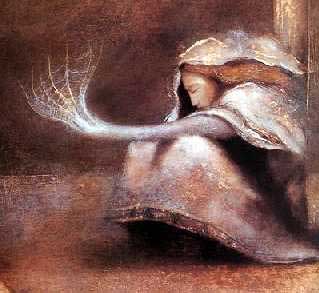
The two Legends or Myths of the Dreamcatcher
Share
Myth 1
Long ago, in the ancient world of the Ojibwe Nation, the Clans were all located in a general area of that place known as Turtle Island.
Thus the ancient Ojibwe storytellers tell how the Spider Woman Asibikaashi helped Wanabozhoo return the giizis (sun) to the people.

To this day, Asibikaashi builds his special hut before dawn. If you are awake at dawn, as it should be, look for his hut and you will see this miracle of how he caught the sunrise as the light sparkles in the dew that gathers there.
Asibikaasi cared for his children, the people of the land, and continues to do so today.
When the Ojibwe nation scattered to the four corners of North America to fulfill a prophecy, Asibikaashi had difficulty reaching all those cradles, so mothers, sisters and nokomis (grandmothers) took up the practice of weaving the magical webs for the new babies using willow hoops and sinew or strings made from plants.
Their circular shape represents the giizis' daily journey through the sky.
The dreamcatcher will filter out all the bad bawedjigewin (dreams) and only allow good thoughts to enter our mind when we are abinooji. You will see a small hole in the center of each dreamcatcher through which these good bawadjige can enter. With the first rays of sunshine, the bad dreams will vanish.
When we see the little asibikaashi, we should not fear it, but respect and protect it. In honor of its origin, the number of points where the cloth was connected to the hoop was 8, for the eight legs of Spider Woman, or 7, for the Seven Prophecies.
It was also traditional to put a feather in the center of the dreamcatcher; it represents breath or air.
It is essential for life. A baby watching the air playing with the feather in its cradle is entertained while receiving a lesson on the importance of good air.
This one lesson is manifested in that the owl's feather is kept for wisdom (woman's feather) and the eagle's for courage (man's feather). This is not to say that the use of each is restricted by gender, but rather that in using the feather each is aware of the gender properties it invokes. (Indians, in general, are very specific about gender roles and identity).
Myth 2
Long ago, when the world was young, an old Lakota spiritual leader stood on a high mountain and had a vision.
In his vision, Iktomi, the great trickster and teacher of wisdom, appeared in the form of a spider.
Iktomi spoke to him in a sacred language that only the spiritual leaders of the Lakota could understand.
As he spoke, Iktomi, the spider, took the old man's willow hoop, which had feathers, horse hair, beads and offerings, and began to weave a web.
He spoke to the old man about the cycles of life...and how we begin our lives as babies and move into infancy, and then into adulthood. Finally, we reach old age, where we must be cared for as infants, completing the cycle.
"But," Iktomi said as he continued to weave his web, "in every moment of life there are many forces, some good and some bad. If you listen to the good forces, they will guide you in the right direction. But if you listen to the bad forces, they will hurt you and lead you in the wrong direction."
He continued, "There are many forces and different directions that can help or interfere with the harmony of nature, and also with the great spirit and all its wonderful teachings."
As the spider spoke, he continued to weave his web starting from the outside and working toward the center.
When Iktomi finished speaking, he handed the web to the Lakota elder and said..... "Look, the cloth is a perfect circle, but there is a hole in the center of the circle."
He added, "Use the web to help yourself and your people achieve your goals and to make good use of the ideas, dreams and visions of your people."
"If you believe in the great spirit, the web will catch your good ideas -- and the bad ones will go through the hole."
The Lakota elder passed on his vision to his people and now the Sioux Indians use the dream catcher as a web of their lives.
They hang it over their beds or in their home to filter their dreams and visions.
All the goods of their dreams are caught in the web of life and carried with them...but the evil of their dreams escapes through the hole in the center of the web and is no longer a part of them.
They believe the dreamcatcher holds the fate of their future.
